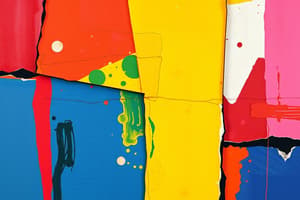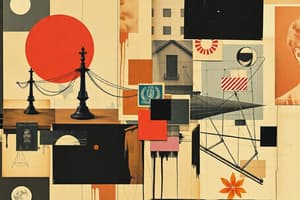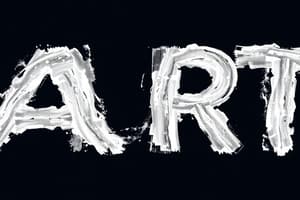Podcast
Questions and Answers
What role does line play in artwork?
What role does line play in artwork?
- It enhances the color palette of the artwork.
- It modifies the texture of surfaces.
- It solely represents color themes.
- It gives structure and shape, guiding the viewer's eye. (correct)
Which element of art is primarily responsible for creating mood and expressing emotions?
Which element of art is primarily responsible for creating mood and expressing emotions?
- Value
- Shape
- Form
- Color (correct)
What is the significance of texture in artwork?
What is the significance of texture in artwork?
- It provides depth and perspective.
- It enhances the tactile quality and visual interest. (correct)
- It determines the color scheme.
- It restricts movement within the composition.
Which of the following elements is concerned with the contrast between light and dark areas?
Which of the following elements is concerned with the contrast between light and dark areas?
What does space in a composition primarily determine?
What does space in a composition primarily determine?
What best describes the concept of transcreation in the arts?
What best describes the concept of transcreation in the arts?
In Vincent Van Gogh's works, which cultural influence is most evident?
In Vincent Van Gogh's works, which cultural influence is most evident?
What is the primary purpose of preserving the original artistic vision during transcreation?
What is the primary purpose of preserving the original artistic vision during transcreation?
What term refers to the visual weight distribution within an artwork?
What term refers to the visual weight distribution within an artwork?
Which of the following exemplifies asymmetrical balance?
Which of the following exemplifies asymmetrical balance?
What element enhances the strengths of different components through noticeable differences?
What element enhances the strengths of different components through noticeable differences?
Which artwork illustrates the idea of ideal human proportions?
Which artwork illustrates the idea of ideal human proportions?
What is the term for an arrangement of repeated elements like shapes or colors?
What is the term for an arrangement of repeated elements like shapes or colors?
Which artwork is characterized by a rhythmic pattern in its waves?
Which artwork is characterized by a rhythmic pattern in its waves?
What design principle is utilized to maintain harmony in size relationships among elements?
What design principle is utilized to maintain harmony in size relationships among elements?
What are the focal points in an image structured by the Rule of Thirds?
What are the focal points in an image structured by the Rule of Thirds?
Which principle is used to capture the viewer's attention in a composition?
Which principle is used to capture the viewer's attention in a composition?
In applying the Rule of Thirds, how should the focal points be utilized?
In applying the Rule of Thirds, how should the focal points be utilized?
How does Samuel Peploe’s Still Life with Coffee Pot exemplify the Rule of Thirds?
How does Samuel Peploe’s Still Life with Coffee Pot exemplify the Rule of Thirds?
Which element of Peploe's composition is positioned on a vertical line in accordance with the Rule of Thirds?
Which element of Peploe's composition is positioned on a vertical line in accordance with the Rule of Thirds?
What is the main purpose of using the Rule of Thirds in composition?
What is the main purpose of using the Rule of Thirds in composition?
What does the Rule of Thirds imply about horizontal and vertical lines?
What does the Rule of Thirds imply about horizontal and vertical lines?
Where would you typically find the focal points when applying the Rule of Thirds?
Where would you typically find the focal points when applying the Rule of Thirds?
Which of the following statements about the Rule of Thirds is incorrect?
Which of the following statements about the Rule of Thirds is incorrect?
What aspect of Van Gogh's painting 'Bridge in the Rain (after Hiroshige)' demonstrates the concept of distortion?
What aspect of Van Gogh's painting 'Bridge in the Rain (after Hiroshige)' demonstrates the concept of distortion?
Which definition best describes the principle of appropriation in art?
Which definition best describes the principle of appropriation in art?
In what way does transformation differ from distortion in the context of transcreation?
In what way does transformation differ from distortion in the context of transcreation?
What is the primary effect of unity in artworks?
What is the primary effect of unity in artworks?
Which of the following artworks exemplifies the concept of transformation?
Which of the following artworks exemplifies the concept of transformation?
What distinguishes Van Gogh's reinterpretation of Eisen's work in 'The Courtesan'?
What distinguishes Van Gogh's reinterpretation of Eisen's work in 'The Courtesan'?
Which artist's work served as a direct inspiration for Aristide Maillol's 'La Nuit'?
Which artist's work served as a direct inspiration for Aristide Maillol's 'La Nuit'?
What is the main characteristic of distortion in transcreation?
What is the main characteristic of distortion in transcreation?
Study Notes
Elements of Art
- Line: Structure and shape, guides the viewer's attention, and expresses emotion or movement
- Shape: Basic forms within a composition; provides organization and creates patterns
- Color: Evokes mood, expresses emotions, and creates visual interest. Symbolism and focal point highlighting.
- Space: Determines the relationship between objects. Depth, perspective, openness, and confinement.
- Texture: Tactile quality; visual and physical interest. Indicates how surfaces would feel.
- Value: Contrast between light and dark. Depth, emphasis, and solidity.
- Form: Represents three-dimensional objects; adds depth and realism.
Transcreation in Art
- Adaptation of creative works by reinterpreting them for new cultural contexts. Preserves essence and purpose.
- Creative adaptation and cultural sensitivity are key.
- Examples:
- Vincent Van Gogh's "The Courtesan" and "Bridge in the Rain," inspired by Japanese prints.
- Rodin's "The Thinker" influences sculptures addressing contemporary issues.
Factors Influencing Transcreation
- Distortion: Changing characteristics, like shape, color, or form. Ex: Van Gogh's "Bridge in the Rain" reinterprets Hiroshige's woodblock print.
- Transformation: Changing medium or context. Ex: Dalí's "Persistence of Memory" adapted into a 3D digital model.
- Appropriation: Using elements from existing work to create something new. Ex: Van Gogh's "The Courtesan" using elements from Keisai Eisen's woodblock print.
Principles of Art
- Provide guidelines for organizing elements within a composition.
- Enhance the overall impact and aesthetic quality.
- Unity: All elements work together harmoniously to create a cohesive whole.
- Balance: Distribution of visual weight. Symmetrical, asymmetrical, and radial.
- Emphasis: Focal point that attracts the viewer's attention. Achieved through contrast, size, or placement.
- Contrast: Noticeable difference between elements, enhancing their strengths.
- Proportion: Size relationships between elements, ensuring harmony and scale.
- Pattern: Arrangement of alternating or repeated elements.
- Variety: Multiple elements used to engage the viewer's attention.
Rule of Thirds
- Dividing an image into thirds horizontally and vertically.
- Focal points are where the lines intersect.
- Emphasizing areas within these intersecting points can enhance the composition.
- Example: Samuel Peploe's "Still Life with Coffee Pot" uses the Rule of Thirds.
Studying That Suits You
Use AI to generate personalized quizzes and flashcards to suit your learning preferences.
Related Documents
Description
This quiz explores the fundamental elements of art, such as line, shape, color, and texture, and how they contribute to artistic expression. Additionally, it delves into the concept of transcreation in art, discussing the adaptation of works for different cultural contexts while maintaining their essence. Test your knowledge of these important artistic principles!




